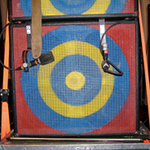While New York’s history of Conceptual art might evoke SoHo lofts, analogous West Coast practices are more often inextricably tied to the university—which isn’t to say that Californian Conceptual art is academic. On the contrary, the twenty-five works in San Diego and the Origins of Conceptual Art in California, made by artists who remain a part of progressive education, are as surprisingly playful as they are implacably serious.
Allan Sekula’s hilarious video of the artist and a friend as hyperactive cooks in the re-creation of a Del Mar pizza parlor sits next to his intense Meditations on a Triptych (1973/78), in which three framed photographs and an essay explore representations of institutional power. Martha Rosler also puts art in the service of critique: The text, diagrams, figures, and photographs in her North American Waitress (1977) demonstrate proper work behavior—little or no jewelry, no gum chewing, no sass—in deference to the presumably male customer. Fred Lonidier’s impressive wall-size work, The Double Articulation of Disneyland (1974), pairing pages of a text by Louis Marin with amusing snapshots of Lonidier and friends visiting the theme park—deconstructs how sponsoring corporations slyly, and often ruthlessly, slip their messages into Disney’s fabricated mythology.
Allan Kaprow and John Baldessari, figureheads of Southern California art education, are duly represented, the latter with Sketch for a Fragment (1966), an early painting that survived his Cremation Project in 1970. Russell W. Baldwin’s ten-inch Soft Ruler (1973), with the phrase ART IS ALL OVER printed on fabric, seems to simultaneously (and self-reflexively) poke fun at measurement-based works and celebrate the ubiquity of art effected, in part, by new Conceptual approaches. Meanwhile, the pictures of abandoned gas stations, newspaper clippings, and other texts documenting the 1973 oil crisis, in Phel Steinmetz’s book work, burn as intensely today as they did thirty-five years ago; and in Hard Times (1971–73), eight unmailed postcards by Eleanor Antin from her “100 Boots” series draw an astute parallel between the economic difficulties then and now.
Originally published at Artforum.com on March 28, 2009.
